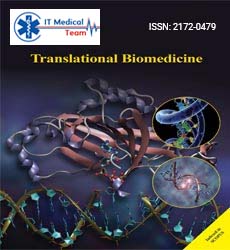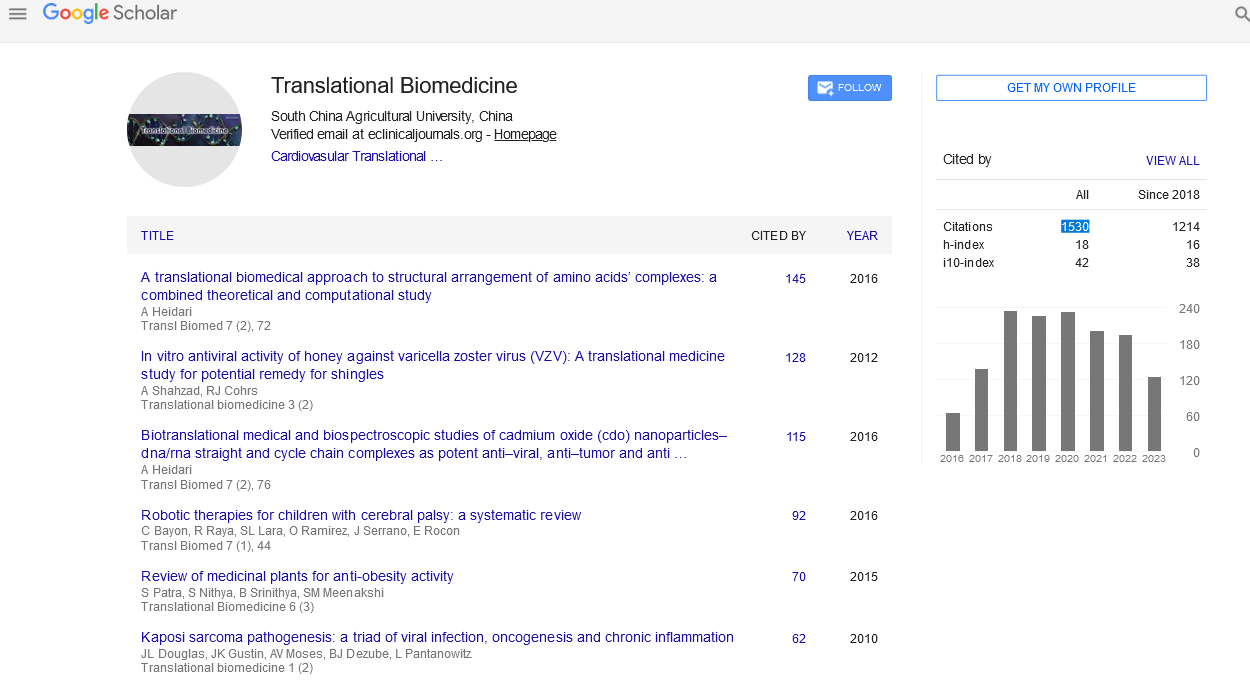Perspective - (2024) Volume 15, Issue 5
Drug Development in Translational Biomedicine
Jian Zhang*
Department of Biomedicine, Wuhhi University, Wuhan, China
*Correspondence:
Jian Zhang, Department of Biomedicine, Wuhhi University, Wuhan,
China,
Email:
Received: 10-Sep-2024, Manuscript No. IPTB-24-15185;
Editor assigned: 13-Sep-2024, Pre QC No. IPTB-24-15185 (PQ);
Reviewed: 27-Sep-2024, QC No. IPTB-24-15185;
Revised: 01-Oct-2024, Manuscript No. IPTB-24-15185 (R);
Published:
29-Oct-2024
Introduction
Translational biomedicine serves as a crucial bridge
connecting laboratory discoveries with clinical applications. At its
heart, drug development is a fundamental aspect of this process,
aiming to translate scientific findings into effective therapeutic
interventions. This article explores the stages of drug
development within the framework of translational biomedicine,
highlighting key challenges and innovations that drive this
complex field.
Description
The translational medicine paradigm
Translational medicine is a multidisciplinary field that integrates
basic scientific research with clinical practice to expedite the
process of discovering and delivering new treatments. It seeks to
transform laboratory-based discoveries into tangible benefits for
patients, thereby shortening the timeline from research to realworld
application. Drug development is a central component of
this paradigm, encompassing a series of stages from initial
discovery to clinical use.
Discovery and preclinical research
The drug development process begins with the discovery
phase, where researchers identify and validate new drug targets.
This involves understanding the molecular mechanisms
underlying diseases and finding potential molecules or
compounds that can interact with these targets. Highthroughput
screening and computational biology are often
employed to accelerate this process.
Once potential drug candidates are identified, they undergo
preclinical testing. This stage involves rigorous laboratory
experiments and animal studies to assess the safety, efficacy and
pharmacokinetics of the drug. Researchers evaluate the drug’s
potential to treat the targeted condition, its toxicity and its
metabolic profile. Successful preclinical studies provide the
foundation for moving forward to clinical trials.
Clinical trials
Clinical trials are conducted in multiple phases, each designed
to address specific aspects of drug safety and efficacy.
Phase I: The primary goal of phase I trials is to assess the
safety of the drug in humans. Typically involving a small number
of healthy volunteers or patients, these trials focus on
determining the appropriate dosage and identifying potential
side effects.
Phase II: Phase II trials involve a larger group of patients and
aim to evaluate the drug’s effectiveness in treating the targeted
disease. Researchers also continue to monitor safety and gather
preliminary data on optimal dosing regimens.
Phase III: This phase includes large-scale trials involving
hundreds to thousands of patients. Phase III trials provide
comprehensive data on the drug’s efficacy and safety, comparing
it to existing treatments or placebos. This stage is critical for
regulatory approval.
Phase IV: Post-marketing surveillance or phase IV, occurs after
the drug has been approved and is available on the market. This
phase involves ongoing monitoring of the drug’s long-term
effects and effectiveness in the general population.
Challenges in drug development
Drug development is fraught with challenges, many of which
arise from the inherent complexity of translating preclinical
findings to clinical success. Some key challenges include:
High failure rates: The transition from preclinical studies to
clinical trials often encounters high failure rates. Many promising
compounds fail to demonstrate efficacy or safety in human
trials, leading to significant financial and time investments being
lost.
Regulatory hurdles: Navigating the regulatory landscape is
complex and varies by region. Regulatory agencies such as the
FDA (U.S. Food and Drug Administration) and EMA (European
Medicines Agency) impose rigorous standards for approval,
which can be challenging for developers to meet.
Personalized medicine: Individual variability in drug response
necessitates the development of personalized medicine
approaches. Understanding how genetic, environmental and lifestyle factors influence drug efficacy and safety is crucial for
tailoring treatments to individual patients.
Innovations and future directions
Despite the challenges, advancements in translational
biomedicine continue to drive progress in drug development.
Key innovations include:
Biomarker discovery: Identifying biomarkers that predict drug
response and disease progression can significantly enhance the
precision of drug development. Biomarkers can help stratify
patients, predict treatment outcomes and monitor drug efficacy.
Advanced therapies: The development of novel therapeutic
approaches, such as gene therapy, cell therapy and personalized
cancer vaccines, represents a promising frontier in drug
development. These therapies aim to address the underlying
causes of diseases at a molecular level.
Conclusion
Drug development within the realm of translational
biomedicine is a dynamic and evolving field. By bridging the gap
between laboratory research and clinical application,
translational medicine aims to accelerate the discovery and
delivery of new treatments. While challenges persist, ongoing
innovations and collaborative efforts are driving progress and
holding promise for the future of drug development. As we
continue to advance our understanding of disease mechanisms
and therapeutic strategies, the potential to improve patient
outcomes and revolutionize healthcare remains a compelling
and achievable goal.
Citation: Zhang J (2024) Drug Development in Translational Biomedicine. Transl Biomed. Vol.15 No.5: 044





